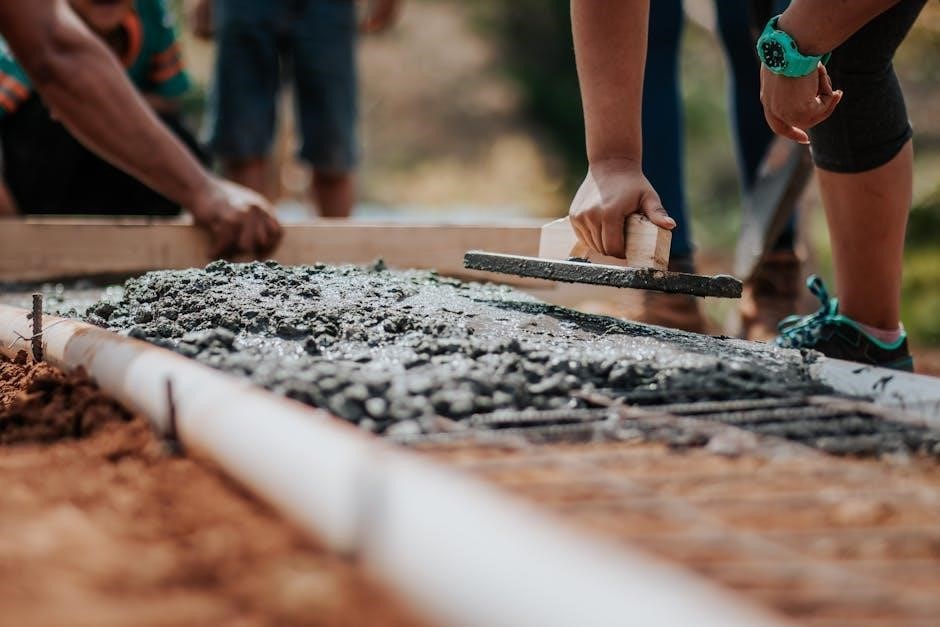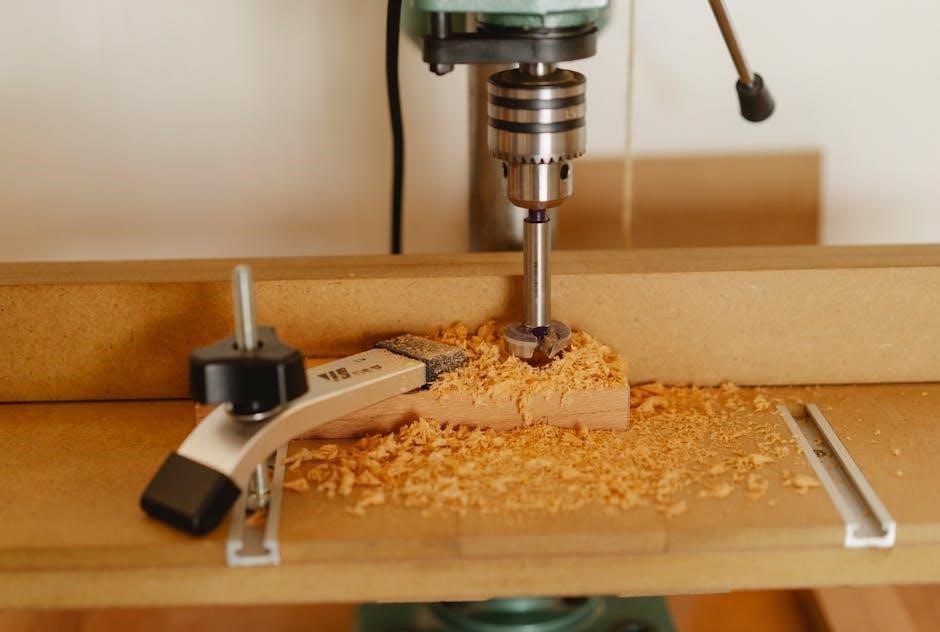The FHWA Drilled Shaft Manual provides a comprehensive resource for engineers designing drilled shaft foundations, covering planning, design, and construction. It emphasizes geotechnical considerations and load testing.
1.1 Overview of the Manual’s Purpose and Scope
The FHWA Drilled Shaft Manual serves as a technical resource for engineers, providing guidelines for the planning, design, and construction of drilled shaft foundations. It covers geotechnical considerations, load testing, and design methods, ensuring a comprehensive approach to foundation engineering. The manual emphasizes practical applications, making it an essential tool for transportation infrastructure projects.
1.2 Importance of Drilled Shafts in Transportation Infrastructure
Drilled shafts are critical for transportation infrastructure, providing deep foundation support for bridges, highways, and other structures. They efficiently transfer heavy loads to stable soil or rock, ensuring structural integrity and safety. The FHWA manual highlights their reliability and versatility, making them essential for modern transportation projects requiring high axial and lateral load capacities while minimizing settlement risks.

Key Concepts and Definitions
- Axial capacity: The maximum load a drilled shaft can withstand without failing.
- Skin friction: The resistance along the shaft’s sides due to soil-shaft interaction.
- End bearing: The resistance at the shaft’s base from the bearing soil or rock.
- Shaft capacity: The sum of skin friction and end bearing capacities.
- Settlement criteria: Limits on shaft deformation under load to ensure structural stability.
2.1 Axial Capacity of Drilled Shafts
The axial capacity of drilled shafts is the maximum load they can support without failure. It is calculated as the sum of skin friction (Qs) and end bearing (Qb) capacities. Skin friction develops along the shaft’s surface due to soil-shaft interaction, while end bearing occurs at the base. Axial capacity is critical for ensuring structural stability and preventing excessive settlement. Proper design ensures the shaft can handle the applied loads safely.
2.2 Skin Friction and End Bearing Capacity
Skin friction (Qs) and end bearing capacity (Qb) are critical components of a drilled shaft’s axial capacity. Skin friction results from the interaction between the shaft’s surface and the surrounding soil, while end bearing capacity is the resistance provided by the soil at the shaft’s base. Together, these components ensure the shaft can transfer structural loads to the ground effectively, maintaining stability and preventing excessive settlement under applied loads.
2.3 Shaft Capacity and Settlement Criteria
Shaft capacity and settlement criteria are essential for ensuring drilled shafts perform reliably under load. Shaft capacity is defined as the maximum load a drilled shaft can sustain without failure, typically when settlement reaches 5% of the shaft diameter. Settlement criteria ensure structural integrity by limiting deformation, balancing load transfer efficiency with acceptable ground movement, as outlined in the FHWA manual.

Geotechnical Considerations for Drilled Shafts
Geotechnical considerations for drilled shafts involve soil and rock classification, determining skin friction, and tip resistance, especially in soft rock, to ensure proper load transfer and settlement analysis.
3.1 Soil and Rock Classification for Foundation Design
Soil and rock classification is fundamental for drilled shaft design, influencing decisions on load transfer and stability. The FHWA manual emphasizes detailed soil properties and rock characteristics to determine skin friction and end-bearing capacity, ensuring proper foundation performance under various conditions. This classification aids engineers in selecting appropriate materials and construction techniques, optimizing structural integrity and safety in transportation infrastructure projects.
3.2 Determination of Skin and Tip Resistance in Soft Rock
Determining skin and tip resistance in soft rock involves assessing the interaction between the drilled shaft and the surrounding rock. The FHWA manual outlines methods to calculate these resistances, emphasizing their impact on axial capacity. Skin resistance depends on rock properties and shaft surface roughness, while tip resistance relies on rock strength and stiffness. Accurate determination ensures reliable foundation design and performance in various geological conditions.

Load Testing and Analysis
Load testing and analysis are crucial for verifying drilled shaft performance. The FHWA manual details methods to conduct load tests and interpret results accurately.
4.1 Methods for Load Testing Drilled Shafts
Load testing is a critical step in verifying drilled shaft performance. Common methods include axial load tests, static load tests, and dynamic tests. Axial load tests apply force along the shaft’s axis to measure capacity and settlement. Static load tests use hydraulic jacks to apply controlled loads, while dynamic tests monitor shaft behavior under impact. These methods ensure compliance with design criteria and provide data for performance evaluation, as detailed in the FHWA manual.
4.2 Interpretation of Load Test Results
Interpreting load test results involves analyzing data to determine axial capacity, skin friction, and end bearing capacity. The shaft’s capacity is defined as the load causing settlement equal to 5% of the diameter. Results help validate design assumptions and ensure compliance with safety criteria. Accurate interpretation is crucial for verifying structural integrity and optimizing foundation performance, as outlined in the FHWA manual.

Design Methods for Drilled Shafts
This section outlines the conventional and LRFD design approaches for drilled shafts, providing engineers with comprehensive methods for foundation design, analysis, and implementation.
5.1 Conventional Design Approach
The conventional design approach for drilled shafts focuses on determining axial capacity by summing skin friction and end bearing resistance. It calculates total capacity as Qt = Qs + Qb, where Qs is skin friction and Qb is end bearing. This method emphasizes ultimate capacity and uses factors of safety to ensure stability. It is widely applied in transportation projects, offering a straightforward framework for engineers to design reliable drilled shaft foundations efficiently.
5.2 Load and Resistance Factor Design (LRFD) Approach
The LRFD approach incorporates load and resistance factors to enhance design reliability. It separates loads and resistances, applying factors to account for uncertainties. Calibration with field test results ensures accuracy, while the method promotes efficient material use. This approach aligns with modern engineering practices, offering improved accuracy and reliability compared to conventional methods. It is widely adopted for drilled shaft design in transportation infrastructure projects.

Construction Procedures and Best Practices
Construction procedures include drilling techniques, casing, and concrete placement. Best practices emphasize proper equipment, quality control, and safety measures to ensure structural integrity and durability of drilled shafts.
6.1 Equipment and Techniques for Drilling
Drilling equipment includes rotary rigs, casing systems, and drilling tools. Techniques involve using drilling fluids to stabilize boreholes and minimize soil disturbance. Augering and reverse circulation methods enhance efficiency in various soil conditions. Proper alignment and depth control are critical for shaft accuracy. Regular equipment maintenance ensures optimal performance and safety during construction. These practices are detailed in the FHWA manual to guide engineers and contractors effectively.
6;2 Quality Control During Construction
Quality control ensures drilled shafts meet design and safety standards. Key steps include monitoring concrete placement, verifying casing alignment, and checking shaft depth. Documentation of materials and construction processes is critical. Regular inspections and testing, such as concrete strength verification, are performed. Compliance with specifications and addressing defects promptly are emphasized to maintain structural integrity and performance. These measures ensure reliable and durable foundations for transportation infrastructure.

Common Applications of Drilled Shafts
Drilled shafts are widely used for bridge foundations and high-rise buildings, ensuring structural stability. They also support heavy structures and transportation infrastructure, providing reliable load transfer to the ground.
7.1 Bridge Foundations
Drilled shafts are essential for bridge foundations, providing deep, stable support in challenging soil conditions. They efficiently transfer massive structural loads to competent soils or rock, ensuring long-term durability. This method is particularly effective in areas with soft or unstable ground, where shallow foundations would fail. The FHWA manual outlines design and construction best practices for these critical applications, emphasizing safety and reliability.
7.2 High-Rise Buildings and Heavy Structures
Drilled shafts are widely used for high-rise buildings and heavy structures due to their ability to transfer large loads to deep, stable soil or rock. The FHWA manual provides detailed guidance on designing these foundations, addressing challenges like settlement control and load distribution. This method ensures structural integrity in urban areas with limited space and demanding soil conditions, making it a preferred choice for modern construction projects.

Recent Advancements and Updates
The FHWA manual has been updated to include new design methods, technologies, and sustainability practices, enhancing drilled shaft construction efficiency and safety in modern engineering projects.
8.1 Updates in the FHWA Manual
The FHWA manual has incorporated advancements in geotechnical analysis, updated load testing procedures, and new design methodologies. It reflects current research on skin friction and end bearing capacities, providing engineers with refined tools for drilled shaft design. The manual also addresses environmental considerations and integrates modern construction technologies to ensure safer and more efficient foundation systems.
8.2 New Technologies in Drilled Shaft Construction
Recent advancements include the use of advanced drilling rigs, real-time monitoring systems, and high-strength materials. Automation and sensors now optimize drilling accuracy and safety. New concrete mixes enhance durability, while eco-friendly practices reduce environmental impact. These innovations streamline construction processes, improve quality, and ensure compliance with modern engineering standards, making drilled shafts more efficient and sustainable for large-scale infrastructure projects.

Case Studies and Practical Examples
Real-world applications of drilled shafts are highlighted through case studies, showcasing successful projects and challenging scenarios; These examples provide practical insights into design, construction, and problem-solving.
9.1 Successful Projects Using Drilled Shafts
Notable projects, such as the San Francisco-Oakland Bay Bridge, demonstrate the effectiveness of drilled shafts in supporting massive structures under extreme loads. These cases highlight the shafts’ ability to ensure stability and durability, even in challenging soil conditions.
By showcasing real-world applications, engineers can gain insights into optimal design and construction practices, validating the reliability of drilled shafts in critical infrastructure projects.
9.2 Lessons Learned from ChallengingProjects
9.2 Lessons Learned from Challenging Projects
Challenging projects highlight the importance of meticulous planning and adaptability. Unexpected soil conditions and construction delays often require innovative solutions, such as adjusting shaft diameters or depths to ensure stability.
These experiences underscore the value of thorough site investigations and real-time monitoring. They also emphasize the need for collaboration between engineers and contractors to address unforeseen issues, ultimately improving future project outcomes and industry standards.

Future Trends in Drilled Shaft Design and Construction
Future trends emphasize sustainability and integration of emerging technologies, such as advanced materials and digital monitoring, to enhance efficiency and reduce environmental impact in drilled shaft projects.
10.1 Sustainability and Environmental Considerations
Sustainability in drilled shaft design focuses on minimizing environmental impact through advanced materials and construction techniques. The FHWA manual highlights the use of recycled materials and energy-efficient equipment to reduce carbon footprints. Modern methods emphasize eco-friendly practices, such as minimizing soil disturbance and optimizing resource use, aligning with green engineering standards for future infrastructure development.
10.2 Integration with Emerging Technologies
The FHWA manual increasingly incorporates emerging technologies, such as AI-driven design tools and IoT sensors, to enhance drilled shaft construction. Advanced materials and automation are being integrated to improve efficiency and accuracy. These innovations aim to streamline design processes, monitor construction in real-time, and ensure compliance with modern engineering standards, paving the way for smarter and more sustainable infrastructure development.
